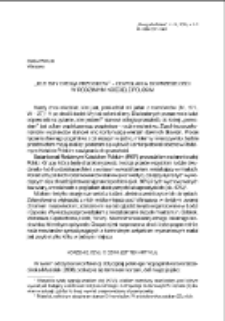- Wyszukaj w całym Repozytorium
- Piśmiennictwo i mapy
- Archeologia
- Baza Młynów
- Nauki przyrodnicze
Wyszukiwanie zaawansowane
Wyszukiwanie zaawansowane
Wyszukiwanie zaawansowane
Wyszukiwanie zaawansowane
Wyszukiwanie zaawansowane

Obiekt
Tytuł: „Idziemy drogą przodków” – Odwołania do przeszłości w Rodzimym Kościele Polskim
Inny tytuł:
Etnografia Polska 59 Z. 1-2 2015 (2016)
Wydawca:
Instytut Archeolgoii i Etnologii Polskiej Akademii Nauk
Miejsce wydania:
Opis:
Typ obiektu:
Abstrakt:
The article examines relation between neopagan native faith and reenactment movement at an example of the Native Polish Church members. Instead of presenting reenactment events in which they participate, it focuses on certain attitude towards the past which characterizes both the faithful and reenactors. They all feel a certain bond to the early medieval Slavic legacy and continue it, some of them combining participation in the Church with reenactment. The author interprets ethnographic data showing how the bond to the past is understood and in which aspects of life it plays a crucial role. The feeling of connection to the early medieval Slavs is, however, examined critically and the author defends thesis that sources of contemporary renewal of native religions should be seen rather in the idea of New Age movement and not in the notion of historical continuity
Bibliografia:
Barcikowska Alicja 2009, Autoportret polskich (neo)pogan. Prezentacja wyników ankietowych, [w:] Neopogaństwo w Polsce, tom 2, red. A. Gajda i J. Majchrowski, Państwo i społeczeństwo, t. 9, z. 4, s. 23–44
Giddens Anthony 2001, Nowoczesność i tożsamość. „Ja” i społeczeństwo w epoce późnej nowoczesności, Wydawnictwo Naukowe PWN SA, Warszawa
Hall Dorota 2007, New Age w Polsce: lokalny wymiar globalnego zjawiska, Wydawnictwa akademickie i profesjonalne, Warszawa
Kopińska Marta 2011, Język jako narzędzie interpretacji rzeczywistości – językowy obraz świata, www.ehu.es/ojs/index.php/Mundo/article/download/1580/1252
Pasek Zbigniew 2008, Neopogaństwo w Polsce a duchowość New Age, [w:] Neopogaństwo w Polsce, red. A. Gajda i J. Majchrowski, Państwo i społeczeństwo, t. 8, z. 4, s. 203–212
Pełka Leonard 2008, Przeszłość i teraźniejszość. Ślady wierzeń słowiańskich w kulturze polskiej, [w:] Przeszłość i tożsamość. Społeczno-kulturowe aspekty polskiego neopogaństwa, red. P. Wiench, Wydawnictwo SGGW, Warszawa, s. 63–72
Potrzebowski Stanisław 2009, Rodzimowiercza tożsamość i jej źródła, [w:] Neopogaństwo w Polsce tom 2, red. A. Gajda i J. Majchrowski, Państwo i społeczeństwo, t. 9, z. 4, s. 93–106
Simpson Scott 2000, Native faith: Polish neo-paganism at the brink of the 21st century, Nomos, Kraków
Szczecińska-Musielak Ewa 2008, Antropologiczne i socjologiczne aspekty korzeni, [w:] Przeszłość i tożsamość. Społeczno-kulturowe aspekty polskiego neopogaństwa, red. P. Wiench, Wydawnictwo SGGW, Warszawa, s. 35–48
Thomas Nicholas 1992, The inversion of tradition, American Ethnologist, t. 19, z. 2, s. 213–232
Tomasiewicz Jarosław 1994, Stare religie nowej ery. Główne nurty współczesnego neopoganizmu, Nomos – kwartalnik religioznawczy, nr 5–6
Wilkowski Ratomir 2013, Rodzimowierca, poganin, neopoganin, Gniazdo, nr 1 (13)
Czasopismo/Seria/cykl:
Tom:
Zeszyt:
Strona pocz.:
Strona końc.:
Szczegółowy typ zasobu:
Format:
Identyfikator zasobu:
oai:rcin.org.pl:61315 ; 0071-1861
Źródło:
IAiE PAN, sygn. P 325 ; IAiE PAN, sygn. P 326 ; IAiE PAN, sygn. P 327 ; kliknij tutaj, żeby przejść
Język:
Prawa:
Prawa zastrzeżone - dostęp nieograniczony
Zasady wykorzystania:
Digitalizacja:
Instytut Archeologii i Etnologii Polskiej Akademii Nauk
Lokalizacja oryginału:
Biblioteka Instytutu Archeologii i Etnologii PAN
Dostęp:
Kolekcje, do których przypisany jest obiekt:
- Repozytorium Cyfrowe Instytutów Naukowych > Kolekcje Partnerów > Instytut Archeologii i Etnologii PAN > Publikacje Pracowników i Wydawnictwa IAE PAN
- Repozytorium Cyfrowe Instytutów Naukowych > Kolekcje Partnerów > Instytut Archeologii i Etnologii PAN > Publikacje Pracowników i Wydawnictwa IAE PAN > Czasopisma bieżące
- Repozytorium Cyfrowe Instytutów Naukowych > Piśmiennictwo > Czasopisma/Artykuły
- Repozytorium Cyfrowe Instytutów Naukowych > Kolekcje Partnerów > Instytut Archeologii i Etnologii PAN > Publikacje Pracowników i Wydawnictwa IAE PAN > Czasopisma bieżące > Etnografia Polska
Data ostatniej modyfikacji:
2 lut 2022
Data dodania obiektu:
23 gru 2016
Liczba pobrań / odtworzeń:
1907
Wszystkie dostępne wersje tego obiektu:
https://rcin.org.pl./publication/80483
Wyświetl opis w formacie RDF:
Wyświetl opis w formacie RDFa:
Wyświetl opis w formacie OAI-PMH:
| Nazwa wydania | Data |
|---|---|
| Pawlik, Olga, 2015 (2016), „Idziemy drogą przodków” – Odwołania do przeszłości w Rodzimym Kościele Polskim | 2 lut 2022 |
Obiekty Podobne
Helbig-Mischewski, Brygitta
Szymański, Wojciech (1932– )
Turczyn, Katarzyna
Baraniecka-Olszewska, Kamila
Antoszewska, Katarzyna Laura

 INSTYTUT ARCHEOLOGII I ETNOLOGII POLSKIEJ AKADEMII NAUK
INSTYTUT ARCHEOLOGII I ETNOLOGII POLSKIEJ AKADEMII NAUK
 INSTYTUT BADAŃ LITERACKICH POLSKIEJ AKADEMII NAUK
INSTYTUT BADAŃ LITERACKICH POLSKIEJ AKADEMII NAUK
 INSTYTUT BADAWCZY LEŚNICTWA
INSTYTUT BADAWCZY LEŚNICTWA
 INSTYTUT BIOLOGII DOŚWIADCZALNEJ IM. MARCELEGO NENCKIEGO POLSKIEJ AKADEMII NAUK
INSTYTUT BIOLOGII DOŚWIADCZALNEJ IM. MARCELEGO NENCKIEGO POLSKIEJ AKADEMII NAUK
 INSTYTUT BIOLOGII SSAKÓW POLSKIEJ AKADEMII NAUK
INSTYTUT BIOLOGII SSAKÓW POLSKIEJ AKADEMII NAUK
 INSTYTUT CHEMII FIZYCZNEJ PAN
INSTYTUT CHEMII FIZYCZNEJ PAN
 INSTYTUT CHEMII ORGANICZNEJ PAN
INSTYTUT CHEMII ORGANICZNEJ PAN
 INSTYTUT FILOZOFII I SOCJOLOGII PAN
INSTYTUT FILOZOFII I SOCJOLOGII PAN
 INSTYTUT GEOGRAFII I PRZESTRZENNEGO ZAGOSPODAROWANIA PAN
INSTYTUT GEOGRAFII I PRZESTRZENNEGO ZAGOSPODAROWANIA PAN
 INSTYTUT HISTORII im. TADEUSZA MANTEUFFLA POLSKIEJ AKADEMII NAUK
INSTYTUT HISTORII im. TADEUSZA MANTEUFFLA POLSKIEJ AKADEMII NAUK
 INSTYTUT JĘZYKA POLSKIEGO POLSKIEJ AKADEMII NAUK
INSTYTUT JĘZYKA POLSKIEGO POLSKIEJ AKADEMII NAUK
 INSTYTUT MATEMATYCZNY PAN
INSTYTUT MATEMATYCZNY PAN
 INSTYTUT MEDYCYNY DOŚWIADCZALNEJ I KLINICZNEJ IM.MIROSŁAWA MOSSAKOWSKIEGO POLSKIEJ AKADEMII NAUK
INSTYTUT MEDYCYNY DOŚWIADCZALNEJ I KLINICZNEJ IM.MIROSŁAWA MOSSAKOWSKIEGO POLSKIEJ AKADEMII NAUK
 INSTYTUT PODSTAWOWYCH PROBLEMÓW TECHNIKI PAN
INSTYTUT PODSTAWOWYCH PROBLEMÓW TECHNIKI PAN
 INSTYTUT SLAWISTYKI PAN
INSTYTUT SLAWISTYKI PAN
 SIEĆ BADAWCZA ŁUKASIEWICZ - INSTYTUT TECHNOLOGII MATERIAŁÓW ELEKTRONICZNYCH
SIEĆ BADAWCZA ŁUKASIEWICZ - INSTYTUT TECHNOLOGII MATERIAŁÓW ELEKTRONICZNYCH
 MUZEUM I INSTYTUT ZOOLOGII POLSKIEJ AKADEMII NAUK
MUZEUM I INSTYTUT ZOOLOGII POLSKIEJ AKADEMII NAUK
 INSTYTUT BADAŃ SYSTEMOWYCH PAN
INSTYTUT BADAŃ SYSTEMOWYCH PAN
 INSTYTUT BOTANIKI IM. WŁADYSŁAWA SZAFERA POLSKIEJ AKADEMII NAUK
INSTYTUT BOTANIKI IM. WŁADYSŁAWA SZAFERA POLSKIEJ AKADEMII NAUK




































